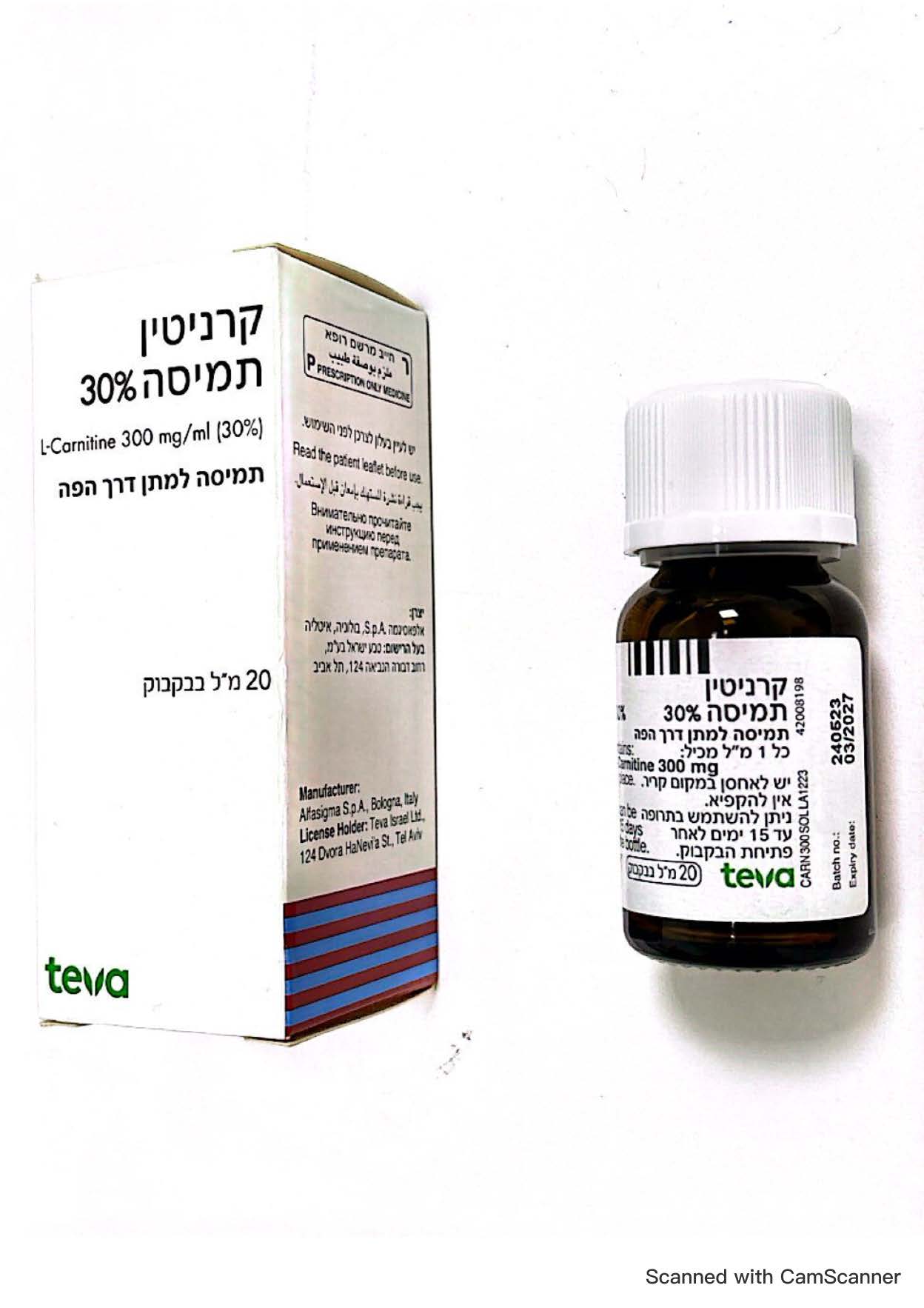Quest for the right Drug

קרניטין תמיסה % 30 CARNITINE SOLUTION 30% (LEVOCARNITINE)
תרופה במרשם
תרופה בסל
נרקוטיקה
ציטוטוקסיקה
צורת מתן:
פומי : PER OS
צורת מינון:
תמיסה : SOLUTION
עלון לרופא
מינוניםPosology התוויות
Indications תופעות לוואי
Adverse reactions התוויות נגד
Contraindications אינטראקציות
Interactions מינון יתר
Overdose הריון/הנקה
Pregnancy & Lactation אוכלוסיות מיוחדות
Special populations תכונות פרמקולוגיות
Pharmacological properties מידע רוקחי
Pharmaceutical particulars אזהרת שימוש
Special Warning עלון לרופא
Physicians Leaflet
Pharmacological properties : תכונות פרמקולוגיות
Pharmacodynamic Properties
5.1 Pharmacodynamic properties Pharmacotherapeutic category: mitochondrial agonist. ATC: A16AA01 Carnitine is a natural component of the cell where it plays an essential role in energy production and transport. In fact, Carnitine is the only carrier used by long chain fatty acids both to cross the internal mitochondrial membrane, and to lead towards beta-oxidation; moreover L-carnitine controls the transport of the mitochondrial energy to the cytoplasm by modulating the adenine-nucleotide- translocase enzyme. The highest carnitine tissue concentration is found in skeletal muscles and myocardium; although the latter is able to use various substrates for energy production, it normally uses fatty acids. Carnitine therefore plays an essential role in the cardiac metabolism, since the oxidation of fatty acids strictly depends on the presence of an adequate amount of the substance. Experimental studies have shown that in several conditions such as stress, acute ischemia and diphtheric myocarditis, a decrease of Carnitine levels in myocardial tissues can be shown. Many animal models have confirmed a positive activity of Carnitine in a variety of induced heart dysfunctions: acute and chronic ischemia, cardiac decompensation, cardiac insufficiency due to diphtheritic myocarditis, drug-induced cardiotoxicity (propranolol, adriamycin). L-carnitine has shown therapeutic activity in the following pathologies: a) Primary carnitine deficiencies characterized by phenotypes such as myopathies with lipidic accumulation, Reye’s syndrome-type hepatic encephalopathy and/or progressive dilatative cardiomyopathy. b) Secondary carnitine deficiencies in patients with genetic organic acidurias such as propionic acidemia, methyl-malonic aciduria, isovaleric acidemia and in patients with genetic beta- oxidation defects. In these situations the secondary carnitine deficiency shows as esters with fatty acids. In fact, endogenous L-carnitine acts as a “buffer” for fatty acids that cannot be metabolized. c) Secondary carnitine deficiencies in patients undergoing intermittent haemodialysis. Muscular depletion of L-carnitine is directly related to the loss of this substance in the dialysis fluid. The muscular symptoms typically seen in these patients after the dialytic session, have been shown to be improved with the exogenous treatment.
Pharmacokinetic Properties
5.2 Pharmacokinetic properties After oral administration, L-carnitine is degraded by the intestinal bacteria to trimethylamine (TMA) and gamma-butyrobetaine. Since the amount of the drug that reaches unchanged the systemic circulation is approximately 10-20%, it is estimated that the intestinal metabolism is responsible for the elimination of approximately 80-90% of an oral dose of L-carnitine. The products of the intestinal metabolism, gamma-butyrobetaine and TMA are both absorbed. Gamma-butyrobetaine is found unchanged in the urine while TMA is transformed by hepatic metabolism in trimethylamine-N-oxide (TMAO) that is found in the urine together with small quantities of unchanged TMA. Chronic oral administration of L-carnitine in patients with severe renal impairment or undergoing dialysis may cause accumulation of TMA and TMAO in the blood with subsequent trimethylaminuria, a pathological condition characterized by a strong "fish odour" of urine, breath and sweat of the patient.

שימוש לפי פנקס קופ''ח כללית 1994
לא צוין
תאריך הכללה מקורי בסל
01/01/1995
הגבלות
תרופה שאושרה לשימוש כללי בקופ'ח
מידע נוסף
